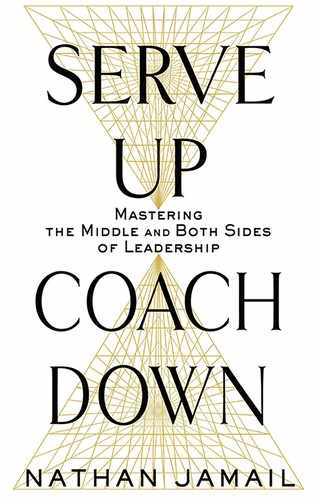INTRODUCTION
The Leader in the Middle
One of the most difficult leadership positions in business today is also the most common: the “leader in the middle.” Leading from the middle simply means you lead a team (sometimes many teams of hundreds of people) and simultaneously report to someone as your boss. And how many people do you know who do not answer to anyone? It doesn't matter what their titles are: vice president, senior account executive, manager, director . . . It doesn't matter if they work for a Fortune 500, mid-market company, university, hospital, construction firm . . . It doesn't matter if they're part of a high-technology business in the cloud or legacy brick-and-mortar analog brand.
Simply put, if you lead people and answer to someone—a boss, shareholders, customers—you are among the millions of “leaders in the middle” in business today. Yet too few of those leaders have really figured out how to own the power that comes with that position.
Wait, Nathan, did you just say leading from the middle is powerful? Yes, I did.
Too many leaders don't see it that way. They think the middle is weak, lacks influence, and makes them ineffective at driving change. They feel it's an insult to be called “middle management.” They treat the M like some leadership scarlet letter. But leading from the middle is not a judgment that you must hide from others in shame, and it's most certainly not weak. In fact, those who have mastered the middle are superstars that their bosses are grateful for, employees admire, peers respect, slackers fear, and victims resent. They lead through uncertainty and move at the speed of change that organizations need today.
Those who have failed to master the middle struggle to lead their people relentlessly to achieve success and simultaneously accept direction from their bosses. To solve this problem, what leaders and organizations need is a new approach that changes how they think about leading from the middle. How they prepare. How they execute.
Why do leaders in the middle who care about their teams still struggle to gain their boss's approval? Why do leaders in the middle who feel they serve their teams have so much difficulty getting teams to step it up and go beyond their basic requirements of their jobs? Why do leaders in the middle have issues working with other teams and divisions in the organization, leaving their teams having to do more work?
Because those leaders in the middle too often serve down to their people and defend up to their bosses, instead of serving up to their bosses and coaching down to their employees.
How Did This Happen?
The way most leaders have been taught, trained, and conditioned to lead, serve, and follow is not only misdirected but has hindered their paths to greater success, innovation, and creating cultures filled with stronger, happier employees. The solution to this problem, however, isn't to change direction; it's to shift our mindsets about what it means to serve.
Ever since Robert Greenleaf coined the term “servant leadership” in 1970, countless books have touted it as the way to lead. Invert the traditional hierarchical corporate pyramid and put the leaders at the bottom! Put others first and allow them to influence you! Serve your people! These are noble concepts but flawed in their execution. This is why after years of leadership development and practicing the idea of servant leadership, organizations still struggle to hold their people accountable, lead and execute through change, and align the needs and goals from the top to the bottom. This is also why leaders in the middle struggle to implement servant leadership, why companies struggle to find those leaders, and why traditional approaches too often fail in the long run.
Simply put, leaders in the middle must be willing to serve up to those they answer to, but to serve those they lead they must coach down.
We serve up to those we follow by: believing in them, following their directions, and working for the greater good of the organization.
We coach down to serve those we lead by: focusing on making them better, demanding they believe in themselves, and expecting they achieve greatness by becoming the best versions of themselves.
Yes, leaders should care about their people and allow them greater influence. But what good are leaders—and how much are they really able to care for their people—if they take the idea of serving people literally? Great leaders don't feed their people fish; they coach them on how to fish for themselves and then kick every competitor's ass by catching more of them. Those people in return serve those leaders and the people those leaders serve by delivering maximum performance for the organization.
We Need a New Playbook for Success
Achieving this level of performance requires leaders in the middle to focus, have confidence, and commit to changing their mindsets. That's what this book helps you do: realize your power by shifting your mindset to embrace the power of the middle by striking the necessary balance between coaching those you lead and serving those who lead you. When you understand the influence and impact you can have by serving up and coaching down, everyone wins, and you realize the power you have as a leader in the middle. You become more successful—better, faster, and stronger as a leader in the middle simply by shifting to a serve up/coach down mindset and doing things a little differently than you've been taught.
Put aside traditional notions of servant leadership and learn to serve up to your bosses, serve out to your peers, and coach down to those you lead with humility, selflessness, and confidence. It's time to change the way we lead from the middle by transforming it and owning it as a difficult, underappreciated, and more powerful position than we have ever realized.
